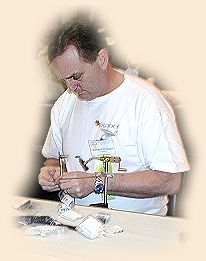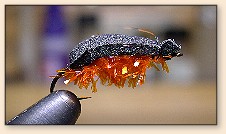
The Crystal Beetle is a fly that I like to use
under trees and bushes. It is a foam beetle with
small crystal chenille wrapped around the hook
before the foam is pulled over. I tend to let
this fly hit the water a little harder than the
other flies. I think that it may act more like a
beetle when it falls from the vegetation. I use
several colors of crystal chenille under the foam
for this fly. Let the fish tell you which one is
working better. I used orange on this one so it
would show up better. I have this with red, purple,
green and yellow for the underbody.
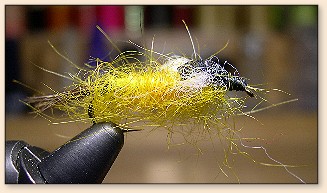
The Floating/suspending nymph is one that I came up
with. It is a simple tie with a few changes that I
put in. This fly is tied a little exaggerated for
you to see all the parts. Depending on the width of
the foam wing case and the dubbing used this fly
can float near the surface or suspend in the water
column. I fish this fly very - very slowly. A forty
foot cast can take over 10 minutes to bring in if no
fish hit it. When fish take this fly they usually
hit it hard. Most of the gills that I have seen jump
out of the water to land on top of a fly have done
it with this fly, when it is floating at the surface.
Materials Floating/suspending nymph
Hook - size 6 to 12.
Thread - Black.
Tail - Pheasant feather barbs or biots.
Abdomen - Shaggy dubbing loosely wrapped.
Wingcase - Foam (a small ball of polyester batting under the foam).
Thorax - More dubbing to match abdomen.
Hackle - Black.
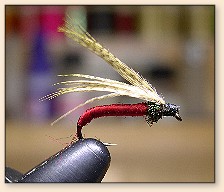
The next is a pattern that I ran into some
place and can not remember the name. If you
know the name let me know. It is a simple tie
of a thin red floss body, with one turn of
peacock herl at the head and some wood duck
feather barbs for a wing. This fly has worked
best for me in size 12 to 16. I usually end up
fishing it over shallower water. Most fish have
hit it on the drop so I do not really retrieve
this fly. I make short casts and keep making
them a little longer each time to cover the
area.
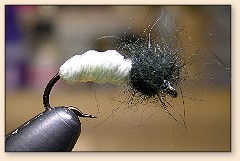
The Rat Tail Grub is a pattern that I received
from Tony Spezio. It is a simple tie but sure
works under any vegetation that hangs over the
pond. The rat tail is a cord that comes from
craft stores. I also use some super glue at
the bend when I first tie this fly to help hold
it. Fish hit this fly with authority. I cast it
out and let it drop. I have not caught many fish
while retrieving this fly. Many times I have to
use forceps to get the fly out as the gills have
taken it so deeply.
Materials Rat Tail Grub
Hook - Hook size 10 to 12.
Thread - To match body.
Body - White or cream rat tail.
Head - Black dubbing sparse.
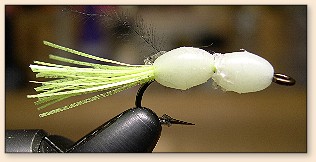
This is a fly that purists may not like. It is
called Bailey's Nite Light. It is tied on a size
8 or 10 hook. You put on luminescent flash materials
and then glue the two beads on. They are soft glow
beads found in the walleye section in the Cabela's
catalog. This is the only place that I have found
them. This fly works at night and in dingy water.
I use this fly a lot after it has rained and the
ponds have a lot of matter in them. The beads also
come in green. There is white flash material.
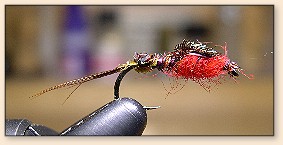
The last is a Pheasant Tail Nymph variation
that I use a lot. This is usually tied as a dropper
on any of the floating flies listed above. I tie it
as follows.: pheasant tail fibers for the tail.
The body is from 4 to 6 colors of pheasant and
turkey tail barbs intermixed to give a mottled
appearance. The wing case is red peacock herl.
The thorax is red dubbing on this one. I also use
ostrich herl for this. This is tied on a larger
hook so you can see more of the fly. I usually
have these tied on size 14 to 18 hooks. I usually
tie them so they are about a foot or so under the
floating fly. Many times this is the first fly taken
and then as the floating fly is moving around it is
taken. I get doubles on this rig about 40% of the
time. I think the fish come up to look at the floating
fly and then take this one.
This is my list for this year and will change in
the future. I am always trying new flies to see
how they work and have some that have done well
but have not replaced these. I hope that this may
help you a little. I have a couple of dozen other
flies that were close to these but were not in the
top twelve.
I hope that you can get out on the water.
~ Rick ziegeria@grm.net
|

